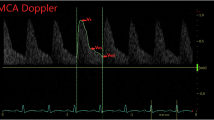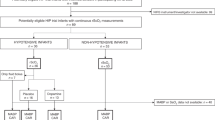Abstract
Background:
Hypotension remains a common complication in preterm infants and is associated with high neonatal morbidity and mortality. The underlying mechanisms are still not fully understood. We studied the microcirculation in extremely low birth weight infants to understand the relationship between blood pressure and skin perfusion.
Methods:
In 21 patients (gestational age <30 wk, birth weight <1,225 g), functional vessel density (FVD) and diameter distribution were obtained prospectively by side stream dark-field imaging at the right arm in the first 48 h after birth. Infants with blood pressure below gestational age and receiving catecholamines were defined as hypotensive as compared with the remaining normotensive control group.
Results:
In the first 6 h after birth, FVD was significantly higher in the hypotensive group than in the control group. After 12 h, there were no significant differences in either blood pressure or FVD between the two groups. FVD did not change significantly during the observation period in either group.
Conclusion:
Hypotensive infants have a higher FVD, possibly due to loss of microvascular tone leading to vasodilation and flow redistribution. However, the link between blood pressure and perfusion remains unclear, and no definitive correlation could be found.
Similar content being viewed by others
Log in or create a free account to read this content
Gain free access to this article, as well as selected content from this journal and more on nature.com
or
References
Efird MM, Heerens AT, Gordon PV, Bose CL, Young DA . A randomized-controlled trial of prophylactic hydrocortisone supplementation for the prevention of hypotension in extremely low birth weight infants. J Perinatol 2005;25:119–24.
Fanaroff AA, Fanaroff JM . Short- and long-term consequences of hypotension in ELBW infants. Semin Perinatol 2006;30:151–5.
Seri I . Circulatory support of the sick preterm infant. Semin Neonatol 2001;6:85–95.
Barrington KJ . Hypotension and shock in the preterm infant. Semin Fetal Neonatal Med 2008;13:16–23.
Limperopoulos C, Bassan H, Kalish LA, et al. Current definitions of hypotension do not predict abnormal cranial ultrasound findings in preterm infants. Pediatrics 2007;120:966–77.
Logan JW, O’Shea TM, Allred EN, et al.; ELGAN Study Investigators. Early postnatal hypotension and developmental delay at 24 months of age among extremely low gestational age newborns. Arch Dis Child Fetal Neonatal Ed 2011;96:F321–8.
Schmaltz C . Hypotension and shock in the preterm neonate. Adv Neonatal Care 2009;9:156–62.
Barrington KJ . Low blood pressure in extremely preterm infants: does treatment affect outcome? Arch Dis Child Fetal Neonatal Ed 2011;96:F316–7.
Batton BJ, Li L, Newman NS, et al.; Eunice Kennedy Shriver National Institute of Child Health and Human Development Neonatal Research Network. Feasibility study of early blood pressure management in extremely preterm infants. J Pediatr 2012;161:65–9.e1.
Seri I, Noori S . Diagnosis and treatment of neonatal hypotension outside the transitional period. Early Hum Dev 2005;81:405–11.
Vain NE, Barrington KJ . Feasibility of evaluating treatment of early hypotension in extremely low birth weight infants. J Pediatr 2012;161:4–7.
Nuntnarumit P, Yang W, Bada-Ellzey HS . Blood pressure measurements in the newborn. Clin Perinatol 1999;26:981–96, x.
Trzeciak S, Rivers EP . Clinical manifestations of disordered microcirculatory perfusion in severe sepsis. Crit Care 2005;9:Suppl 4:S20–6.
Goedhart PT, Khalilzada M, Bezemer R, Merza J, Ince C . Sidestream Dark Field (SDF) imaging: a novel stroboscopic LED ring-based imaging modality for clinical assessment of the microcirculation. Opt Express 2007;15:15101–14.
Groner W, Winkelman JW, Harris AG, et al. Orthogonal polarization spectral imaging: a new method for study of the microcirculation. Nat Med 1999;5:1209–12.
Boerma EC, Mathura KR, van der Voort PH, Spronk PE, Ince C . Quantifying bedside-derived imaging of microcirculatory abnormalities in septic patients: a prospective validation study. Crit Care 2005;9:R601–6.
De Backer D, Hollenberg S, Boerma C, et al. How to evaluate the microcirculation: report of a round table conference. Crit Care 2007;11:R101.
Kluckow M . Low systemic blood flow and pathophysiology of the preterm transitional circulation. Early Hum Dev 2005;81:429–37.
Sarkar S, Dechert R, Schumacher RE, Donn SM . Is refractory hypotension in preterm infants a manifestation of early ductal shunting? J Perinatol 2007;27:353–8.
Sassano-Higgins S, Friedlich P, Seri I . A meta-analysis of dopamine use in hypotensive preterm infants: blood pressure and cerebral hemodynamics. J Perinatol 2011;31:647–55.
Seri I . Management of hypotension and low systemic blood flow in the very low birth weight neonate during the first postnatal week. J Perinatol 2006;26:Suppl 1:S8–13; discussion S22–3.
Subhedar NV, Shaw NJ . Dopamine versus dobutamine for hypotensive preterm infants. Cochrane Database Syst Rev 2003:CD001242.
Evans JR, Lou Short B, Van Meurs K, Cheryl Sachs H . Cardiovascular support in preterm infants. Clin Ther 2006;28:1366–84.
Rozé JC, Tohier C, Maingueneau C, Lefèvre M, Mouzard A . Response to dobutamine and dopamine in the hypotensive very preterm infant. Arch Dis Child 1993;69(1 Spec No):59–63.
Ruffolo RR Jr . The pharmacology of dobutamine. Am J Med Sci 1987;294:244–8.
Noori S, Stavroudis TA, Seri I . Systemic and cerebral hemodynamics during the transitional period after premature birth. Clin Perinatol 2009;36:723–36, v.
Weindling AM . Peripheral oxygenation and management in the perinatal period. Semin Fetal Neonatal Med 2010;15:208–15.
Weindling M, Paize F . Peripheral haemodynamics in newborns: best practice guidelines. Early Hum Dev 2010;86:159–65.
Top AP, Ince C, de Meij N, van Dijk M, Tibboel D . Persistent low microcirculatory vessel density in nonsurvivors of sepsis in pediatric intensive care. Crit Care Med 2011;39:8–13.
Top AP, Ince C, Schouwenberg PH, Tibboel D . Inhaled nitric oxide improves systemic microcirculation in infants with hypoxemic respiratory failure. Pediatr Crit Care Med 2011;12:e271–4.
Top AP, Ince C, van Dijk M, Tibboel D . Changes in buccal microcirculation following extracorporeal membrane oxygenation in term neonates with severe respiratory failure. Crit Care Med 2009;37:1121–4.
Stevenson DK, Verter J, Fanaroff AA, et al. Sex differences in outcomes of very low birth weight infants: the newborn male disadvantage. Arch Dis Child Fetal Neonatal Ed 2000;83:F182–5.
Ingemarsson I . Gender aspects of preterm birth. BJOG 2003;110:Suppl 20:34–8.
Stark MJ, Clifton VL, Wright IM . Sex-specific differences in peripheral microvascular blood flow in preterm infants. Pediatr Res 2008;63:415–9.
Hiedl S, Schwepcke A, Weber F, Genzel-Boroviczeny O . Microcirculation in preterm infants: profound effects of patent ductus arteriosus. J Pediatr 2010;156:191–6.
Genzel-Boroviczény O, Christ F, Glas V . Blood transfusion increases functional capillary density in the skin of anemic preterm infants. Pediatr Res 2004;56:751–5.
Genzel-Boroviczény O, Strötgen J, Harris AG, Messmer K, Christ F . Orthogonal polarization spectral imaging (OPS): a novel method to measure the microcirculation in term and preterm infants transcutaneously. Pediatr Res 2002;51:386–91.
Kroth J, Weidlich K, Hiedl S, Nussbaum C, Christ F, Genzel-boroviczény O . Functional vessel density in the first month of life in preterm neonates. Pediatr Res 2008;64:567–71.
Author information
Authors and Affiliations
Corresponding author
PowerPoint slides
Rights and permissions
About this article
Cite this article
Schwepcke, A., Weber, F., Mormanova, Z. et al. Microcirculatory mechanisms in postnatal hypotension affecting premature infants. Pediatr Res 74, 186–190 (2013). https://doi.org/10.1038/pr.2013.78
Received:
Accepted:
Published:
Issue date:
DOI: https://doi.org/10.1038/pr.2013.78
This article is cited by
-
Sex-specific differences in hypertension and associated cardiovascular disease
Nature Reviews Nephrology (2018)
-
The vulnerable microcirculation in the critically ill pediatric patient
Critical Care (2016)



